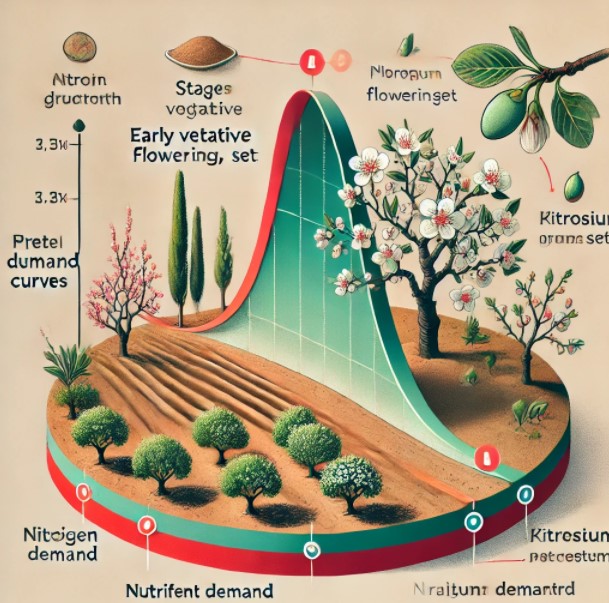
Almond Fertilizer Requirements: Precision-Based Nutrient Demand Curves
Nutrient demand curves offer a more precise approach to fertilizer management compared to the traditional Critical Value method. By understanding the plant’s nutrient uptake patterns throughout its growth cycle, we can tailor fertilizer applications for optimal yield and quality.
Key Components of Nutrient Demand Curves
- Optimal Harvest Time: Phenological Stages: Dividing the crop’s growth cycle into distinct stages to identify critical nutrient demand periods
- Nutrient Uptake Rates: Quantifying the amount of each nutrient absorbed by the plant at different growth stages.
- Fertilizer Timing and Rates: Determining the optimal timing and application rates for different nutrients based on crop demand
- Soil Nutrient Supply: Considering the soil’s ability to provide nutrients and adjusting fertilizer inputs accordingly.
Benefits of Nutrient Demand Curves
- Improved Fertilizer Efficiency: By matching nutrient application to crop needs, we can reduce nutrient losses and environmental impacts.
- Optimized Yield and Quality: Tailored fertilization can lead to higher yields and improved fruit quality.
- Reduced Costs: Avoiding over-fertilization can save on input costs.
Challenges and Considerations
Developing accurate nutrient demand curves requires significant research and data collection. Factors such as cultivar, climate, soil type, and management practices can influence nutrient uptake patterns. Additionally, monitoring plant nutrient status through tissue analysis remains essential for fine-tuning fertilizer recommendations.
By combining nutrient demand curves with other management practices, such as soil testing and plant tissue analysis, we can achieve more sustainable and efficient nutrient management in almonds.
Developing Nutrient Demand Curves for Almond
Methodology
Developing nutrient demand curves for almonds requires a comprehensive approach involving field experimentation, data collection, and analysis. Here’s a proposed methodology:
1. Site Selection:
- Choose representative almond orchards with varying soil types, climate conditions, and management practices.
- Establish experimental plots within these orchards.
2. Treatment Design:
- Implement a factorial design to evaluate the effects of multiple nutrient levels (N, P, K, etc.) and application timings.
- Include control treatments with no additional fertilizer application.
3. Data Collection:
- Monitor tree growth parameters (e.g., leaf area, shoot growth, fruit set, yield).
- Collect regular soil samples to assess nutrient availability.
- Conduct frequent leaf tissue analysis to determine nutrient concentrations.
- Measure meteorological data (temperature, precipitation, solar radiation) to account for environmental factors.
4. Nutrient Application:
- Apply fertilizers based on the experimental design, considering different rates and timings.
- Use appropriate fertilizer sources and application methods.
5. Data Analysis:
- Develop statistical models to relate nutrient application rates to tree growth, yield, and fruit quality.
- Correlate leaf nutrient concentrations with yield and fruit quality parameters.
- Determine critical nutrient levels for optimal growth and production.
- Develop nutrient demand curves based on phenological stages and environmental conditions.
6. Validation:
- Conduct on-farm trials to validate the developed nutrient demand curves under commercial orchard conditions.
- Refine the curves based on field performance and feedback.
Key Considerations
- Nutrient Interactions: Consider the interactive effects of different nutrients on plant growth and yield.
- Soil Testing: Regularly monitor soil nutrient levels to inform fertilizer recommendations.
- Economic Analysis: Evaluate the economic feasibility of different fertilization strategies.
- Environmental Impact: Consider the potential environmental consequences of fertilizer application.
Advantages of liquid Fertilizers
Liquid fertilizers offer several benefits for efficient and effective nutrient management:
- Precision Application: Enables precise delivery of nutrients directly to the root zone, maximizing uptake efficiency.
- Nutrient Completeness: Allows for the application of multiple nutrients in a single pass, simplifying application processes.
- Environmental Benefits: Reduces nutrient runoff and leaching by targeting nutrient placement.
- Flexibility: Offers various application methods (foliar, fertigation) to suit different crop needs and conditions.
- Efficiency: Provides consistent and uniform nutrient distribution across the field.
- Time and Labor Savings: Simplifies application process compared to traditional methods.
- Compatibility: Can be mixed with other crop inputs, such as pesticides, for efficient application.
Fertilizer Program for Almond Orchards: A General Framework
Understanding the Almond Growth Cycle
Almond trees have a distinct growth cycle with critical nutrient demands and specific stages:
- Dormant Period (Late Autumn to Early Spring): Nutrient uptake is minimal, but soil preparation for the upcoming season is essential.
- Bud Break and Bloom (Early Spring): Nitrogen is crucial for shoot and flower development.
- Fruit Set and Growth (Spring to Early Summer): Nitrogen, phosphorus, and potassium are essential for fruit development.
- Kernel Fill (Mid to Late Summer): Potassium and calcium are critical for kernel development and quality.
- Leaf Growth and Hardening (Late Summer to Autumn): Nitrogen and phosphorus are needed for leaf growth and nutrient storage.
General Fertilizer Program
Young Almond Orchards (0-5 years):
- Focus on vegetative growth: Prioritize nitrogen and phosphorus for root and shoot development.
- Regular soil and leaf tissue testing: Monitor nutrient levels and adjust fertilizer applications accordingly.
- Avoid excessive nitrogen: Excessive nitrogen can delay maturity, reduce fruit set, and increase pest and disease susceptibility.
Mature Almond Orchards (5+ years):
- Balanced fertilization: Provide adequate nitrogen, phosphorus, and potassium for optimal growth and yield.
- Split applications: Divide fertilizer applications throughout the growing season to match nutrient demand.
- Foliar feeding: Complement soil-applied fertilizers with foliar sprays for micronutrients and quick corrections.
- Soil testing: Conduct regular soil tests to assess nutrient availability and adjust fertilizer rates accordingly.
Example Fertilization Schedule (Table 1 and 2)
|
Growth Stage |
Primary Nutrients |
Secondary Nutrients |
| Dormant |
Phosphorus, Potassium |
Micronutrients (foliar) |
|
Bud Break and Bloom |
Nitrogen, Phosphorus, Potassium |
Boron, Zinc |
|
Fruit Set and Growth |
Nitrogen, Phosphorus, Potassium, Calcium |
Magnesium, Boron |
|
Kernel Fill |
Potassium, Calcium, Magnesium |
Boron, Zinc |
|
Leaf Growth and Hardening |
Nitrogen, Phosphorus, Potassium |
Micronutrients (foliar) |
Table 1. Nutrient application based on plant growth stages.
Kg/ha/season
| Mineral | Deficient | Optimum | Surplus |
| N | 300 | 250 | 150 |
| P2O5 | 80 | 40 | 0 |
| K2O | 375 | 300 | 50 |
Table 2. General guidelines for seasonal nutrient application (N-P-K) based on foliar analysis conducted in July for the Northern Hemisphere.
Also, in table 3 is presented a general guideline for a nitrogen (N), phosphorus (P), and potassium (K) fertilizer program for almond crops based on typical nutrient demands during the different phenological stages. The percentage distribution is based on the total seasonal nutrient requirements for each stage:
| Phenologikal Stage | Nitrogen (N) % | Phosforus (P) % | Potassium (K) % |
| Dormant | 5% | 5% | 5% |
| Bud Break and Bloom | 15% | 10% | 10% |
| Fruit Set and Growth | 30% | 30% | 35% |
| Kernel Fill | 35% | 40% | 40% |
| Leaf Growth and Hardening | 15% | 15% | 10% |
Explanation:
- Dormant: Minimal nutrient uptake as the tree is not actively growing, but small amounts of NPK are applied to maintain soil fertility.
- Bud Break and Bloom: Increased nutrient demand to support initial growth and flowering.
- Fruit Set and Growth: Significant nutrient uptake as fruits begin to develop, especially potassium for fruit quality and size.
- Kernel Fill: Peak nutrient demand, particularly nitrogen and potassium, to support kernel development.
- Leaf Growth and Hardening: Nutrient demand decreases, but still important for maintaining healthy foliage and preparing the tree for the next season.
This distribution may vary depending on soil analysis, tree health, and environmental factors. Always tailor the program based on local conditions and specific crop needs.
Additional Considerations
- Fertilizer Sources: Choose fertilizers that provide the desired nutrient ratios and are compatible with irrigation systems.
- Fertigation: Consider fertigation for efficient nutrient delivery and water conservation.
- Environmental Factors: Adjust fertilizer rates based on weather conditions, soil type, and irrigation practices.
- Economic Factors: Balance fertilizer costs with potential yield increases and return on investment.
- Soil Testing: Conduct regular soil tests to determine nutrient deficiencies.
- Fertilization: Apply balanced fertilizers based on soil analysis and tree needs.
- Micronutrients: Consider the role of micronutrients in tree health and productivity.
By following these steps and incorporating rigorous data analysis, it is possible to develop accurate nutrient demand curves for almonds and optimize fertilizer management for improved yield and sustainability.






